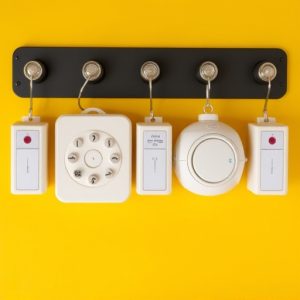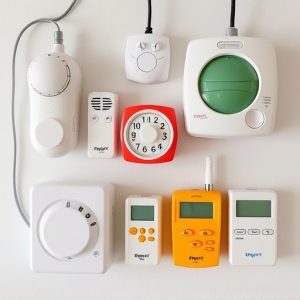Personal Alarms with Alarm Function: Sound Radius, Safety & Legal Guide
Personal alarms with specific sound radius considerations are vital for outdoor safety, deterring th…….
Personal alarms with specific sound radius considerations are vital for outdoor safety, deterring threats with powerful sounds up to 120 dB that penetrate noise and reach distant areas. For rugged environments, durable designs ensure longevity. Best practices involve testing volume and reach (up to 100 meters), positioning near exits indoors, and understanding legalities regarding sound levels and privacy concerns worldwide.
Personal safety is paramount, especially as we navigate an increasingly uncertain world. One powerful tool gaining traction is the personal alarm with an integrated alarm function. This article delves into the significance of these devices, guiding you through essential features, sound radius effectiveness, and best practices for various scenarios. We’ll also explore legal considerations and privacy concerns to ensure informed decisions when choosing a personal safety solution that offers peace of mind outdoors and beyond.
- Understanding Personal Safety Tools: Why an Alarm is Essential
- Key Features to Consider in a Personal Alarm with Alarm Function
- The Science Behind Effective Outdoor Alarm Sound Radius
- Best Practices for Using Personal Alarms in Different Scenarios
- Legal Aspects and Privacy Concerns: What You Need to Know
Understanding Personal Safety Tools: Why an Alarm is Essential
Personal safety tools equipped with alarm functions are essential for anyone prioritizing their well-being, especially when venturing outdoors. In today’s world, where unexpected situations can arise unexpectedly, having a reliable personal alarm can be a game-changer. These compact devices emit a powerful and distinct Personal Alarm Sound designed to startle potential threats and attract attention from passersby, ensuring your safety in various scenarios.
The radius of an alarm’s effective sound is crucial, especially when considering its utility outdoors. A well-designed personal alarm should have a range that allows for effective detection and deterrence, covering areas where you might be vulnerable, such as remote trails or less populated regions. This feature makes it an invaluable companion for outdoor enthusiasts, hikers, and individuals who frequently find themselves in isolated environments, providing them with peace of mind and an added layer of security.
Key Features to Consider in a Personal Alarm with Alarm Function
When choosing a personal alarm with an alarm function, several key features should guide your decision. First and foremost, consider the personal alarm sound radius. The range ensures that your alerts can be heard effectively in various settings, from quiet indoor spaces to bustling outdoors. A wider radius is beneficial for open-air activities or areas with background noise.
Additionally, look for durable designs suitable for outdoor use, as this will enhance the reliability of your alarm system. Water resistance and shockproof capabilities are valuable traits, especially if you plan to use it during unpredictable weather conditions or in rugged environments. These features contribute to the longevity and performance of your personal safety tool.
The Science Behind Effective Outdoor Alarm Sound Radius
The effectiveness of an outdoor personal alarm heavily relies on its sound radius, or the distance at which it can project a loud and clear sound to deter potential threats. This is where science plays a crucial role in designing alarms that are truly effective for personal safety outdoors. The human ear is remarkably sensitive, capable of detecting sounds as low as 0 decibels in ideal conditions. However, ambient noise levels outdoors—from traffic to wildlife—can significantly impact the alarm’s audibility.
For outdoor personal alarms, a sound radius of at least 120 decibels (dB) is recommended by experts to ensure that the alarm is loud enough to startle and scare off potential attackers or intruders. This level of sound intensity can penetrate through ambient noise and reach individuals over a considerable distance. Moreover, some advanced alarms use sound waves in multiple frequency ranges, making them even more effective at reaching diverse audiences and maximizing their deterrence impact.
Best Practices for Using Personal Alarms in Different Scenarios
When utilizing personal alarms with alarm functions, it’s crucial to adopt best practices tailored to various scenarios for optimal effectiveness and safety. For outdoor use, consider the personal alarm sound radius—the range at which the alarm is loud and noticeable enough to deter potential threats. Since alarms are more effective in open spaces, aim to keep them within a 100-meter radius, ensuring passersby or nearby authorities can hear it. In crowded areas like city streets or bustling parks, testing the alarm’s volume and reach beforehand is wise to ensure it stands out above ambient noise.
In indoor settings or enclosed spaces, personal alarms still serve as powerful tools for self-defense. Positioning yourself near an exit when using an indoor alarm can be strategic, allowing quick escape if needed. Additionally, familiarizing yourself with the alarm’s activation and deactivation mechanisms ensures you’re prepared to respond swiftly in unexpected situations. Regularly testing the alarm and keeping it readily accessible will also maximize its utility during emergencies.
Legal Aspects and Privacy Concerns: What You Need to Know
When considering personal safety tools with an alarm function, it’s crucial to understand the legal aspects and privacy concerns associated with their use. The legality of carrying such devices varies by region and jurisdiction. In many places, personal alarms are legal as long as they are used responsibly and within specific sound radius limits, typically around 120 decibels for outdoor use. However, there may be restrictions on the type of alarm tone and its ability to shock or stun, which can vary significantly between different countries and states.
Privacy is another critical factor. Carrying a personal alarm raises concerns about potential false alarms and the impact on bystanders. It’s essential to familiarize yourself with local laws regarding alarm use and ensure you’re not infringing on others’ privacy rights. Additionally, some devices may collect data related to their operation, which can raise further privacy issues. Always review the device’s user manual and settings to understand how your personal safety tool handles data and ensures your privacy while offering much-needed protection.
Personal alarms equipped with alarm functions are powerful tools that can significantly enhance personal safety outdoors. Understanding key features, effective sound radius, and best practices ensures their optimal utilization in various scenarios. By adhering to legal aspects and addressing privacy concerns, individuals can leverage these devices to deter potential threats and raise alertness in today’s digital era. Remember that an informed user is a safer user, and the right personal alarm can be a game-changer in unexpected situations.


